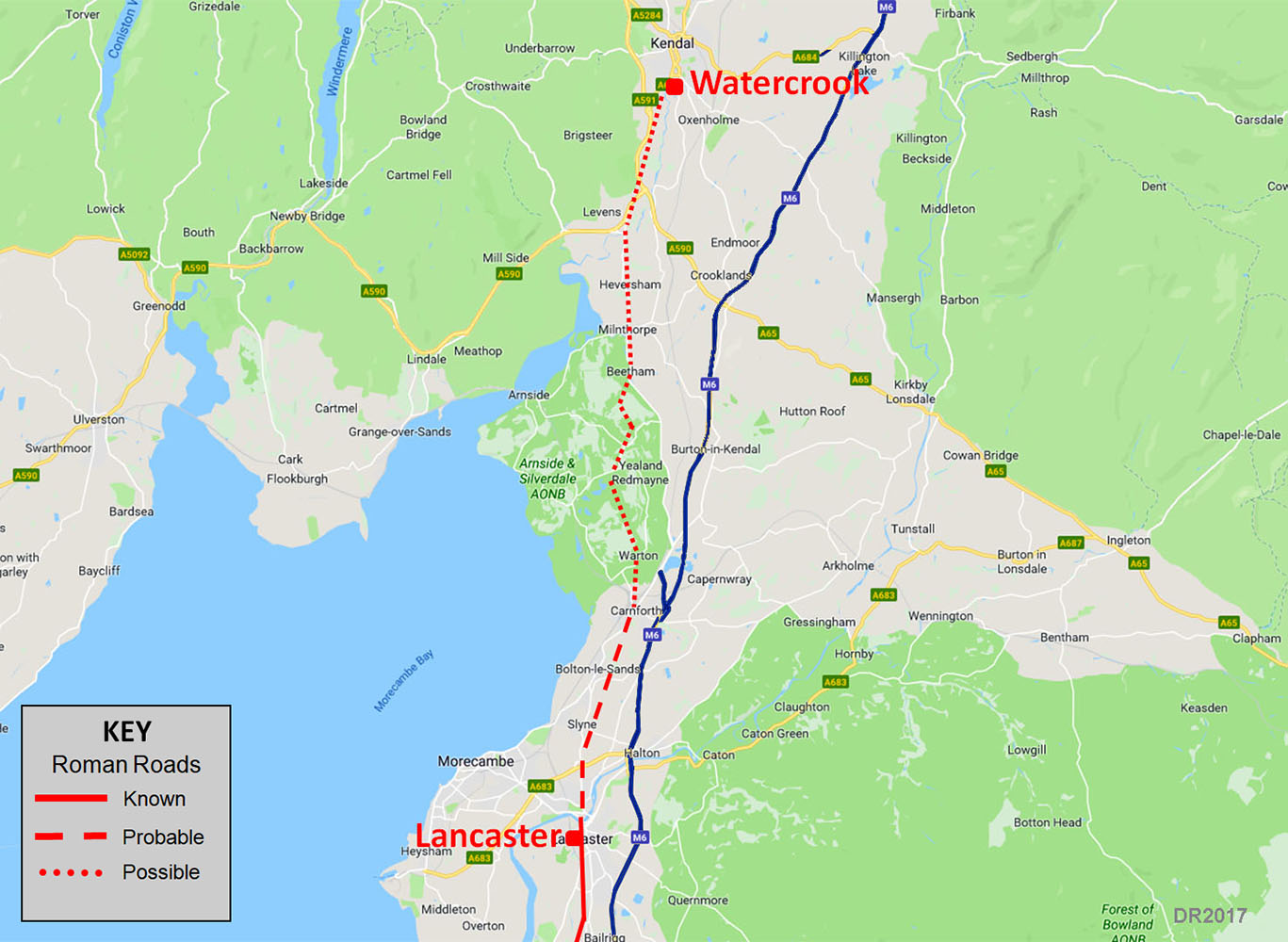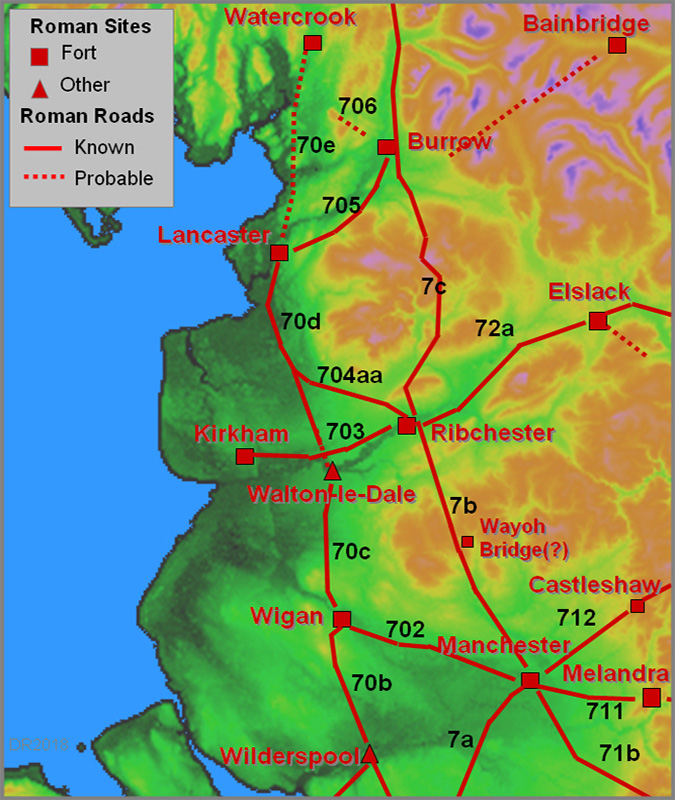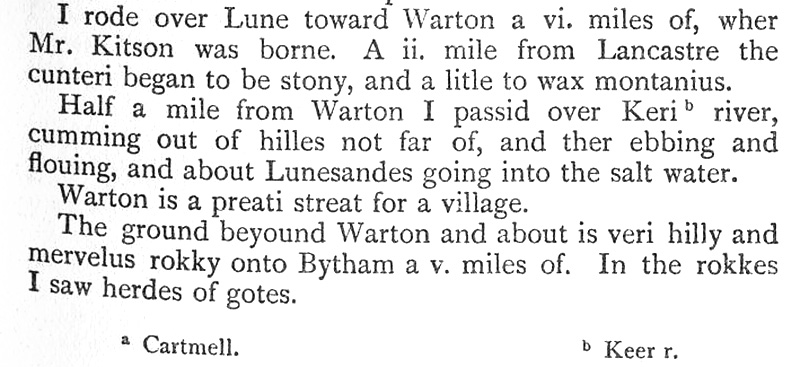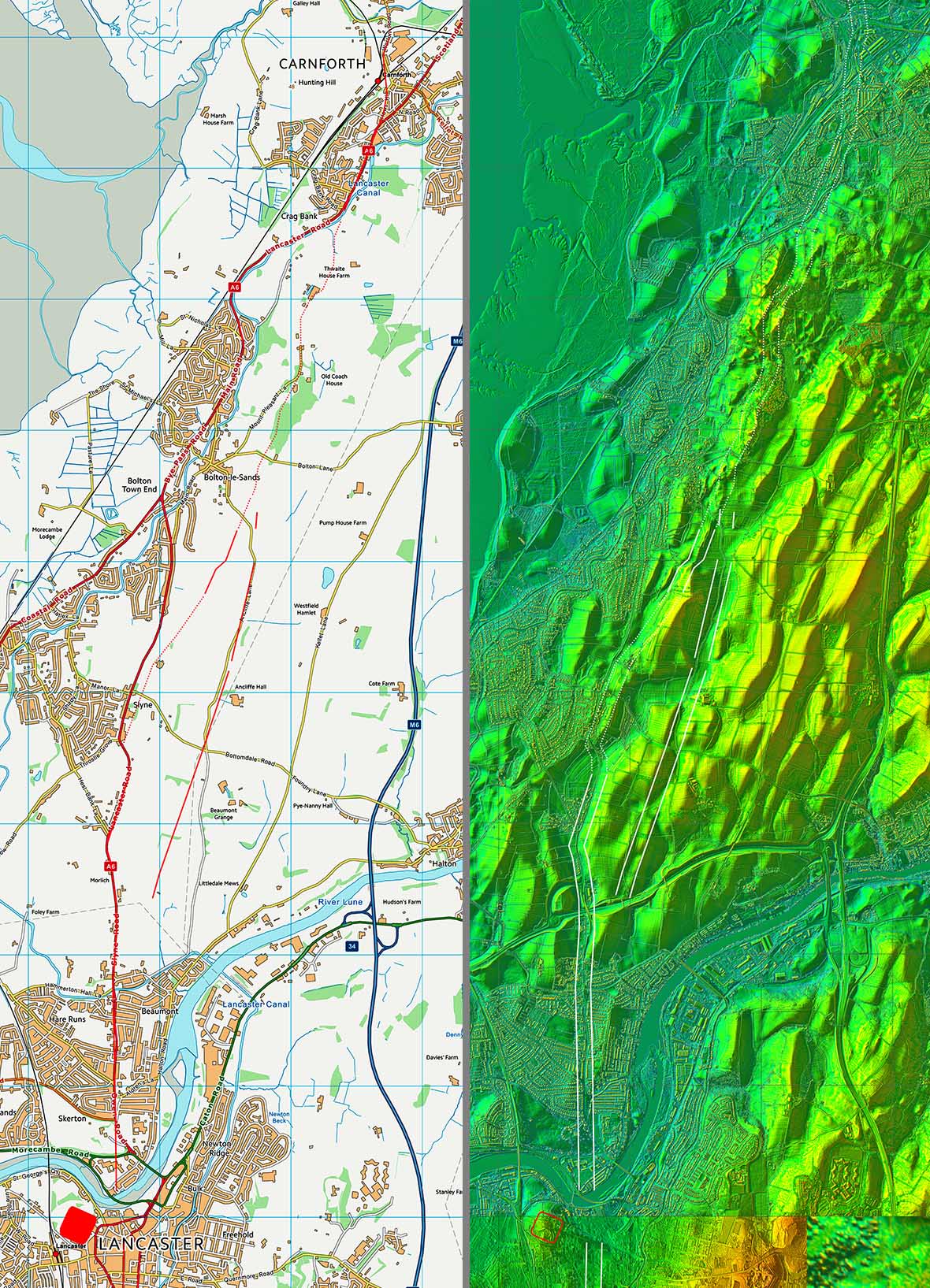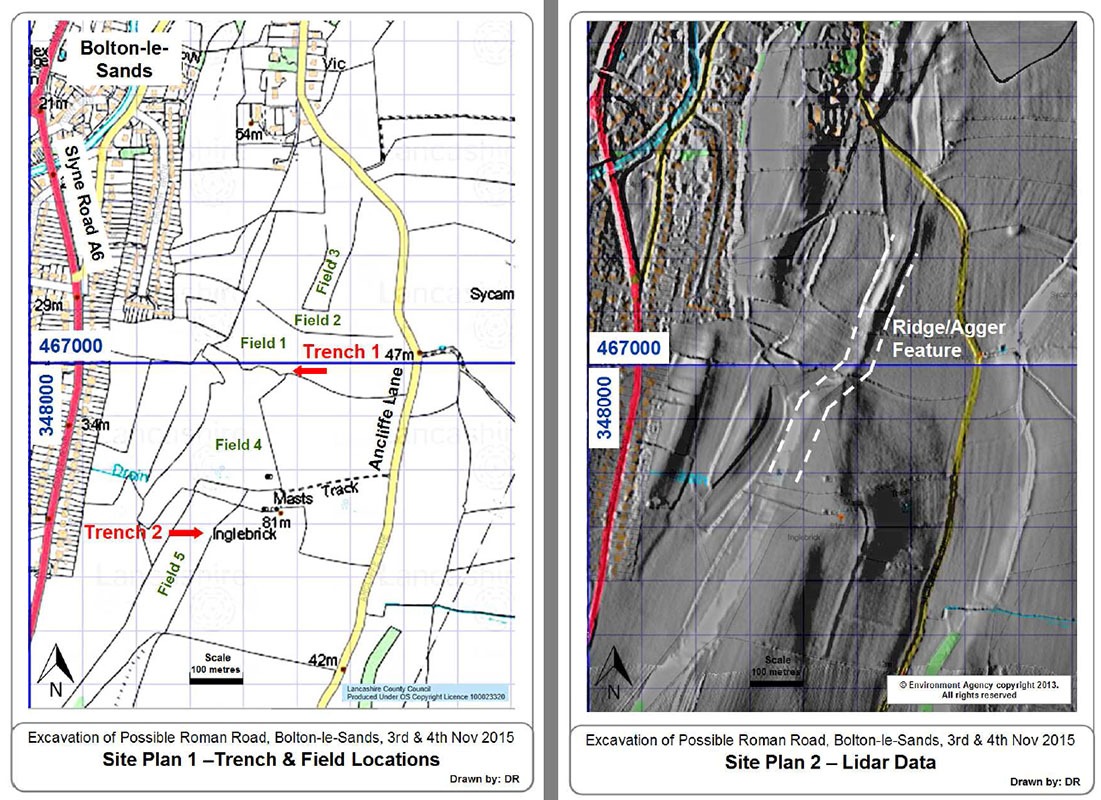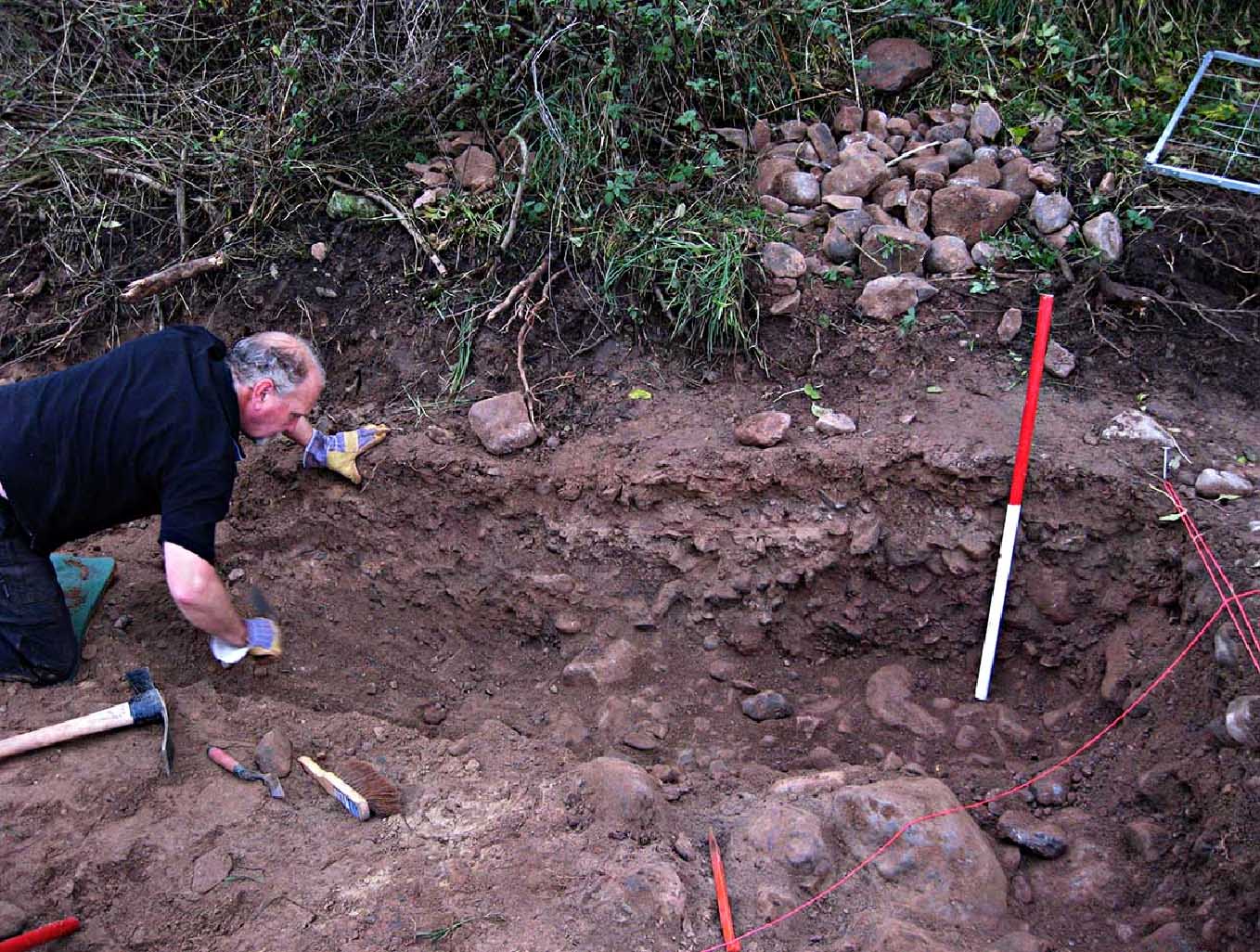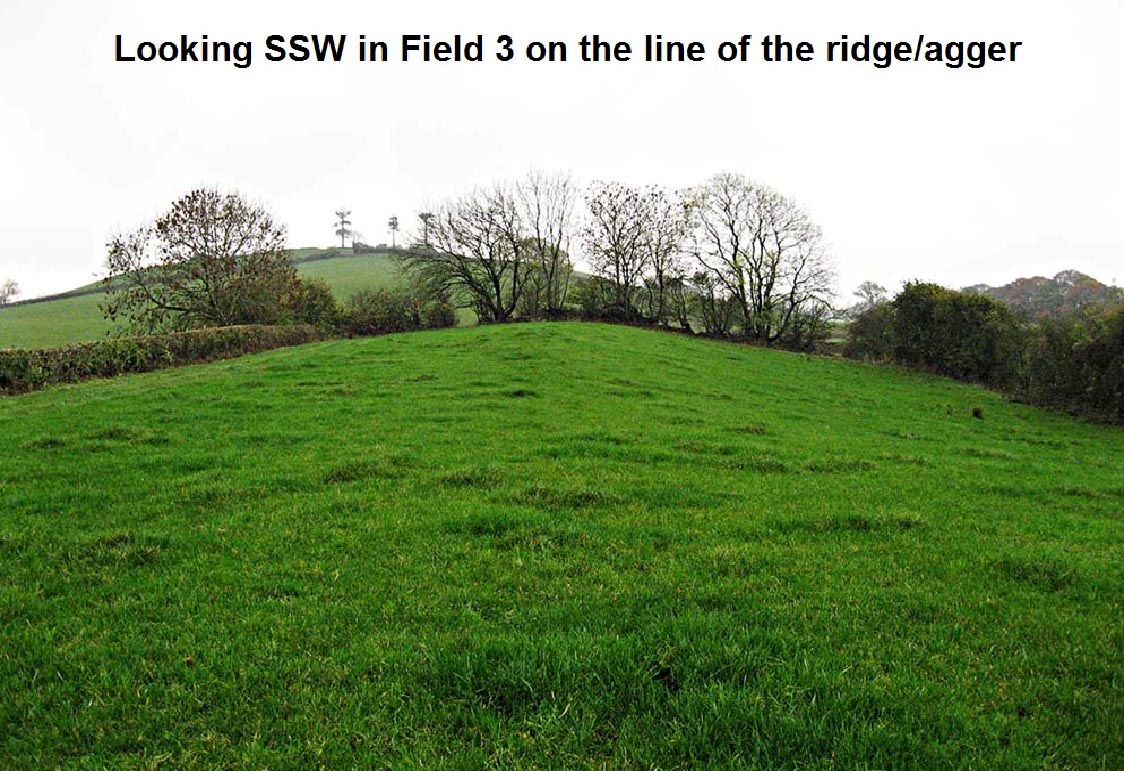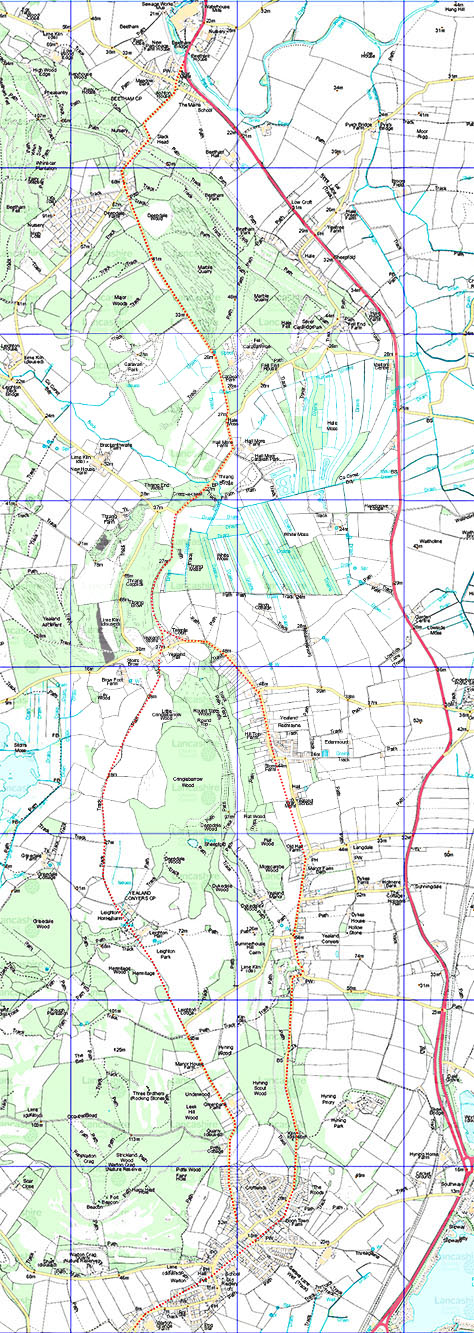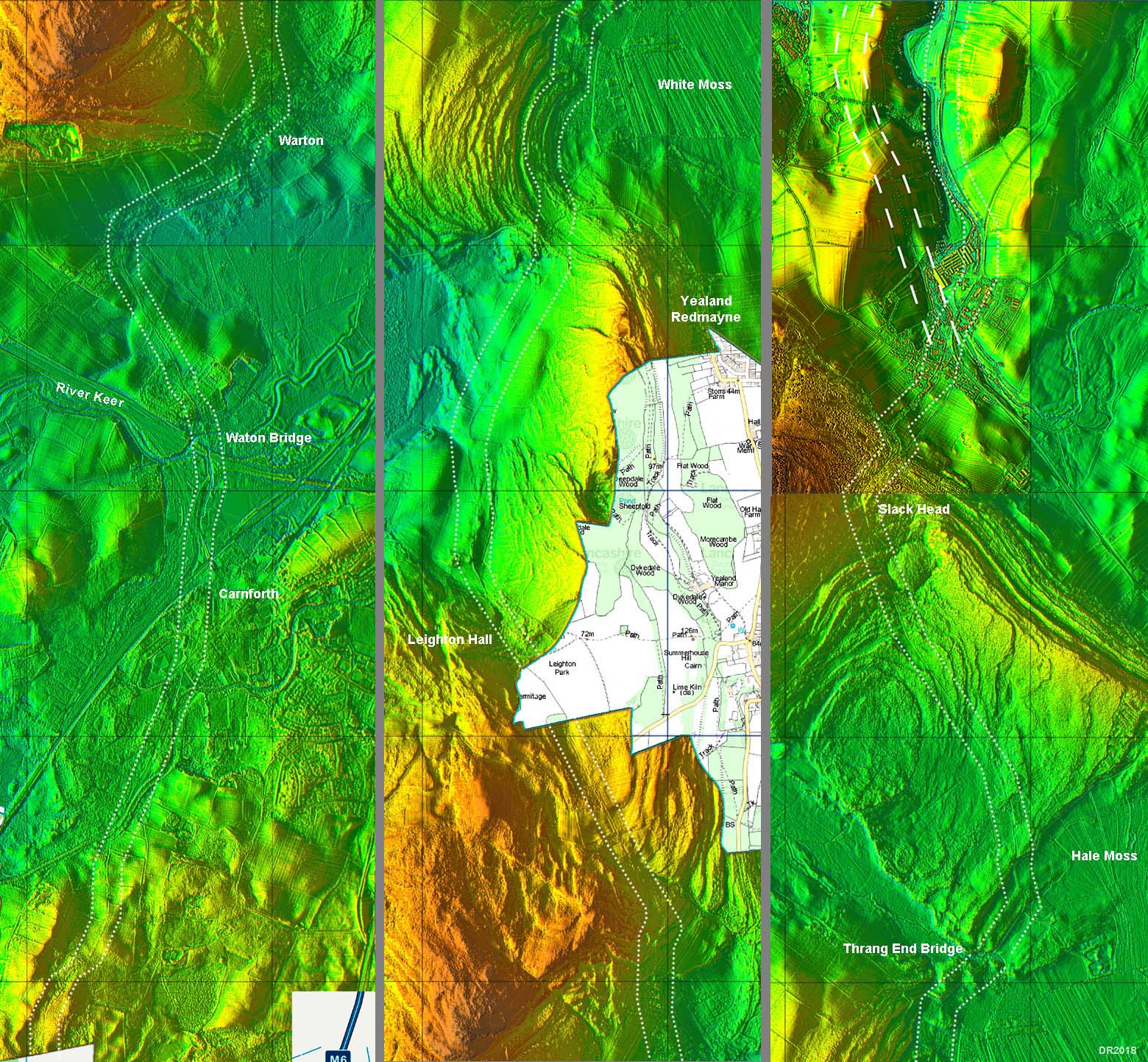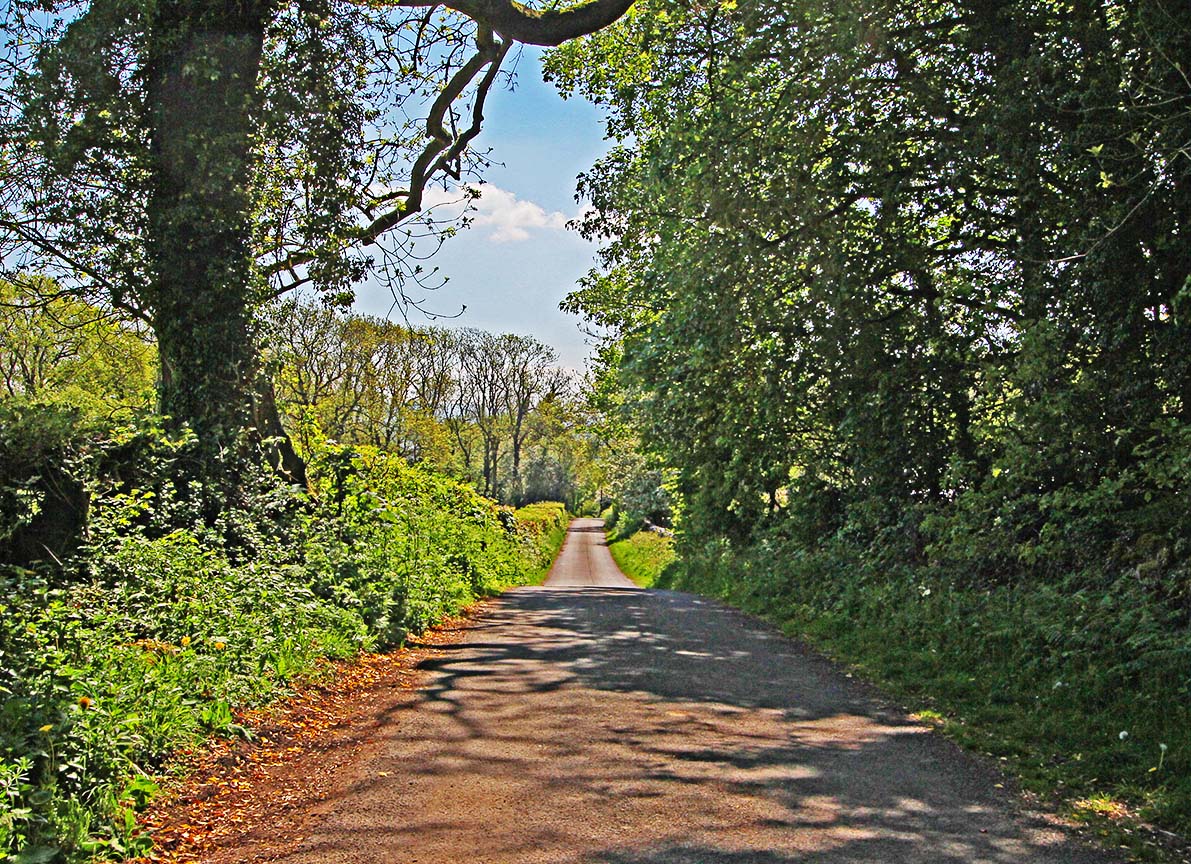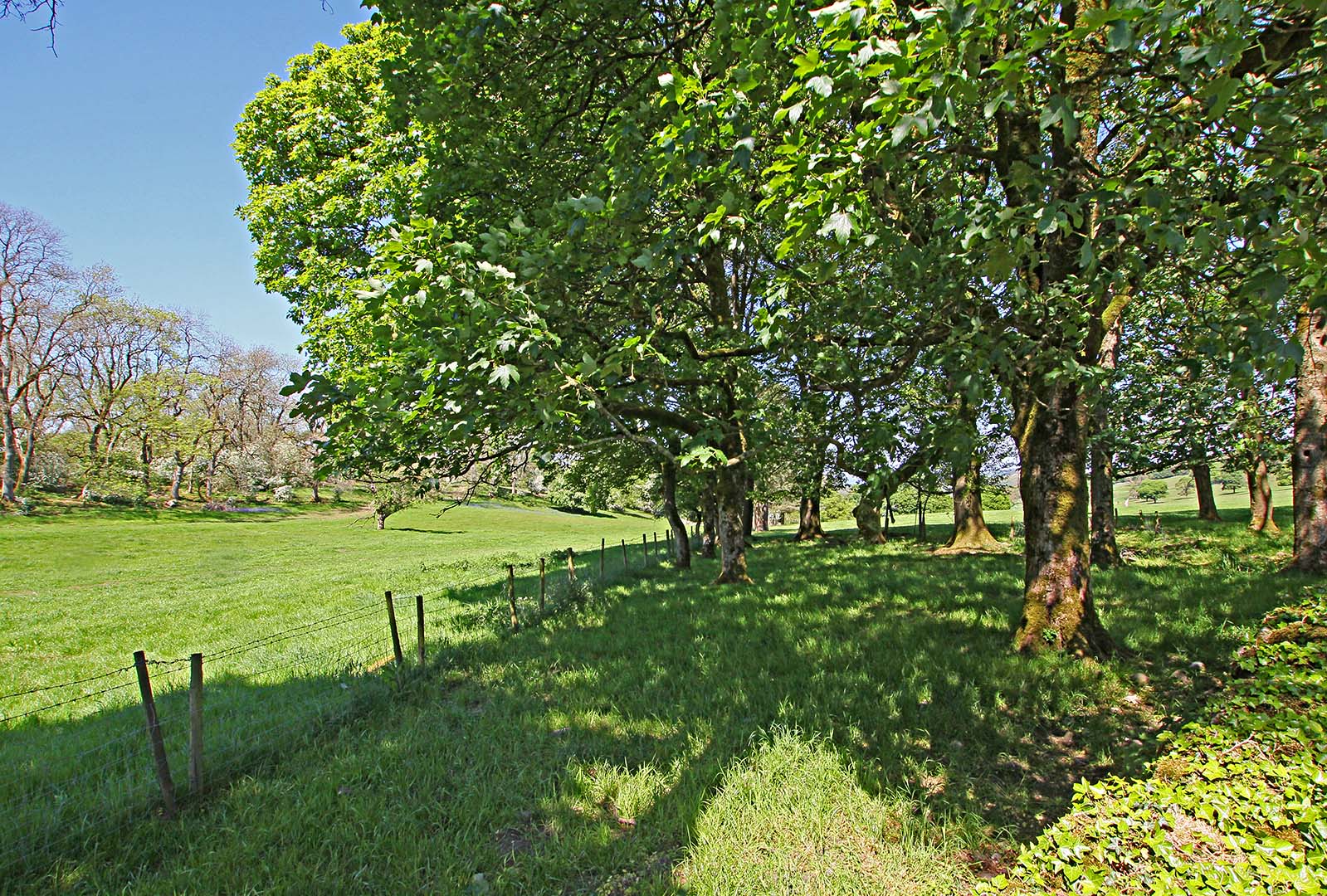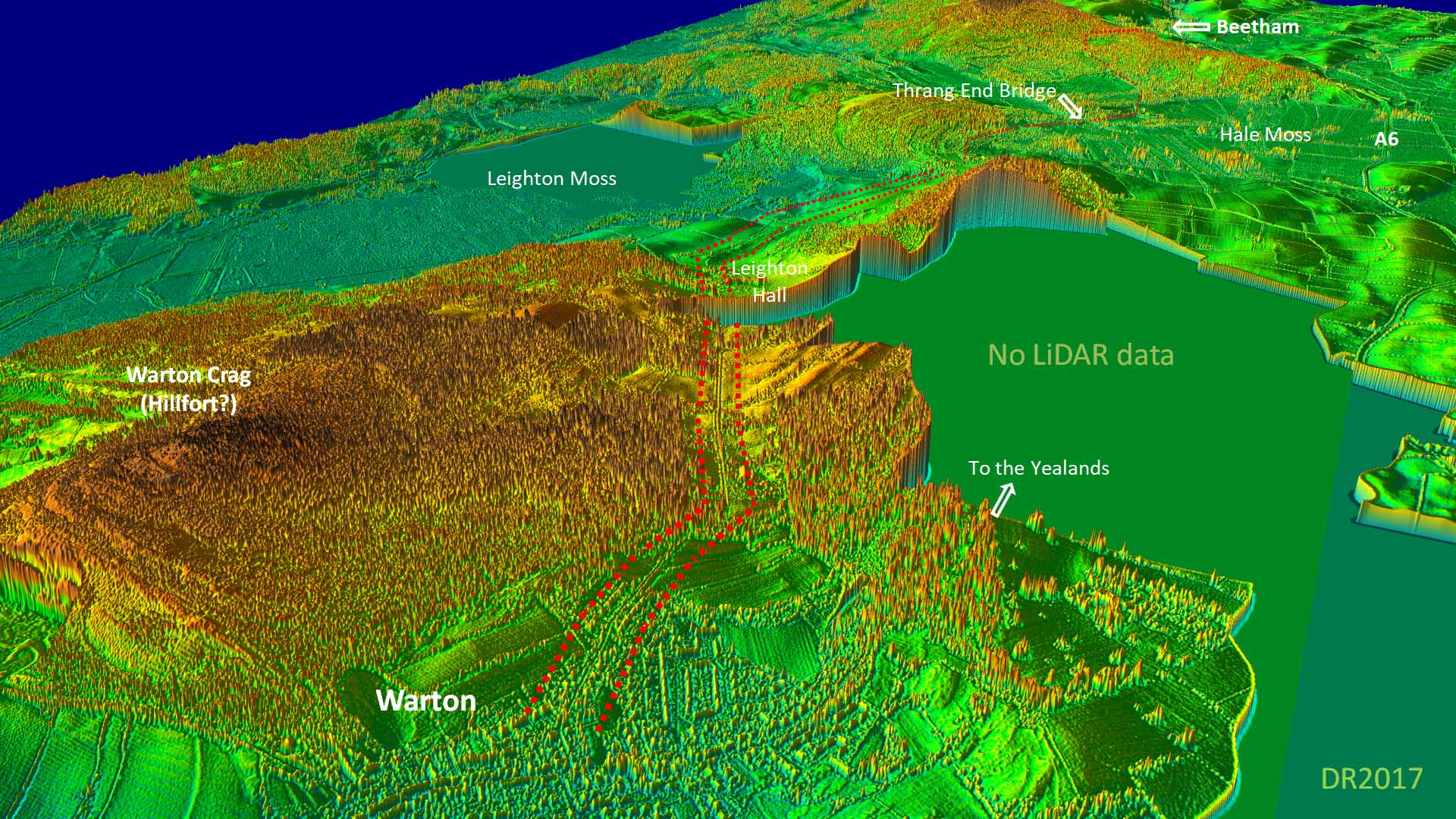
|
The Roman Road from Lancaster to WatercrookMargary Number: 70e (unofficial)Distance: 20 milesAlthough the existence of this road in not really in doubt, solid evidence has proved very elusive. Cumbria HER (Ref 2532) includes a possible Roman road at Deerslet, south of Burton-in-Kendal but describes it as having only "circumstantial evidence". In Lancashire, the last known course for the road is thought to be in Lancaster via Penny Street heading north to a suggested Lune bridge. The route shown on the map is therefore somewhat speculative. Evidence for it is based on Leland's journey c.1540, which south of Lancaster was based on the Roman road. The route he took from Lancaster to Kendal passed through Warton and Beetham (see later). The A6 north of Milnthorpe does also have Roman characteristics supporting this line.. |
Historic County: Lancashire & Westmorland Current County: Lancashire & Cumbria HER: Lancashire & Cumbria
|
|
|
|
|
|
Storrs Lane Junction - looking South towards Leighton Hall Here we are looking back to Leighton Hall from Storrs Lane, Beetham Road Junction. Behind the camera is the road to Beetham via Thrang End Bridge. The road from Leighton Hall to here is now followed by a footpath and the modern road heads left.. Beyond the white fence in this view is a very suggestive agger but it does not align with the current road to Beetham, pointing more to its right (west). Image: DR
|
Click for larger view |
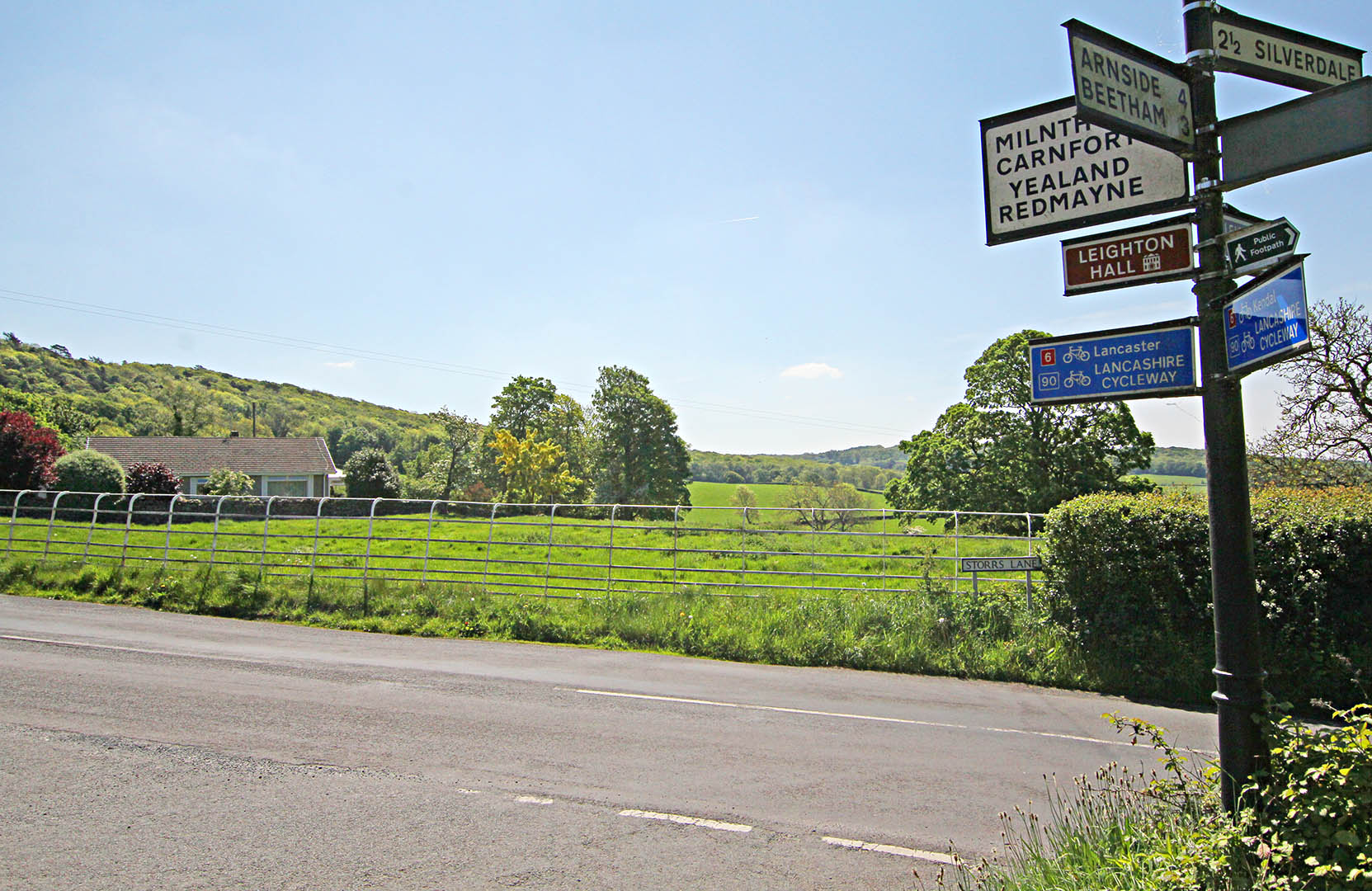 |
Lidar Image - Thrang End Bridge Before White Moss and Hale Moss were drained there was only one practical course keeping to dry land to get to Beetham and that was via Thrang End Bridge. Note: Today Thrang Bridge is a non-entity - drainage has put paid to its former importance.
|
Click for larger view |
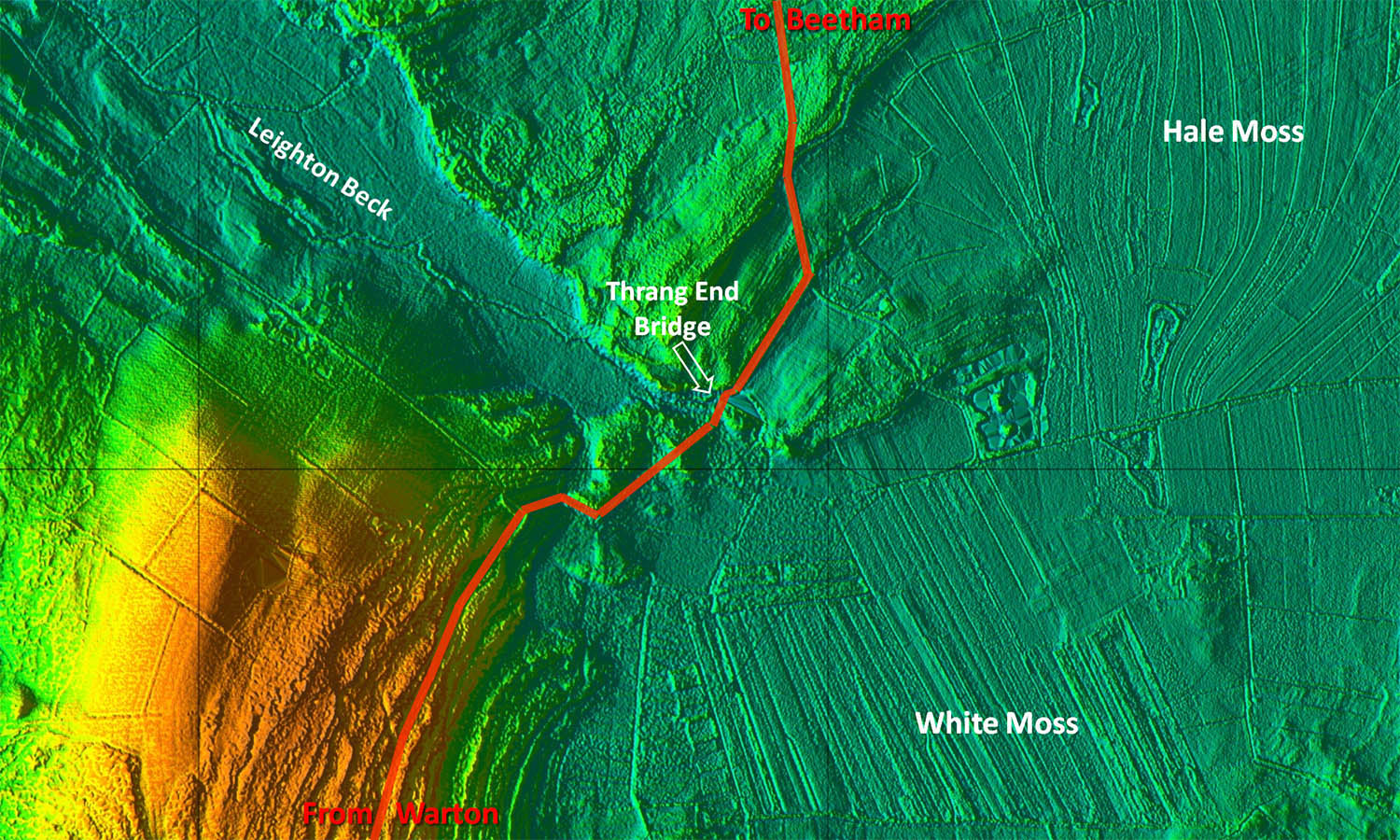 |
Looking south towards Thrang End Bridge Thrang End Bridge is now virtually undetectable and finding it is tricky. With modern drainage it is no longer a critical point for crossing between the mosses. Image: DR |
Click for larger view |
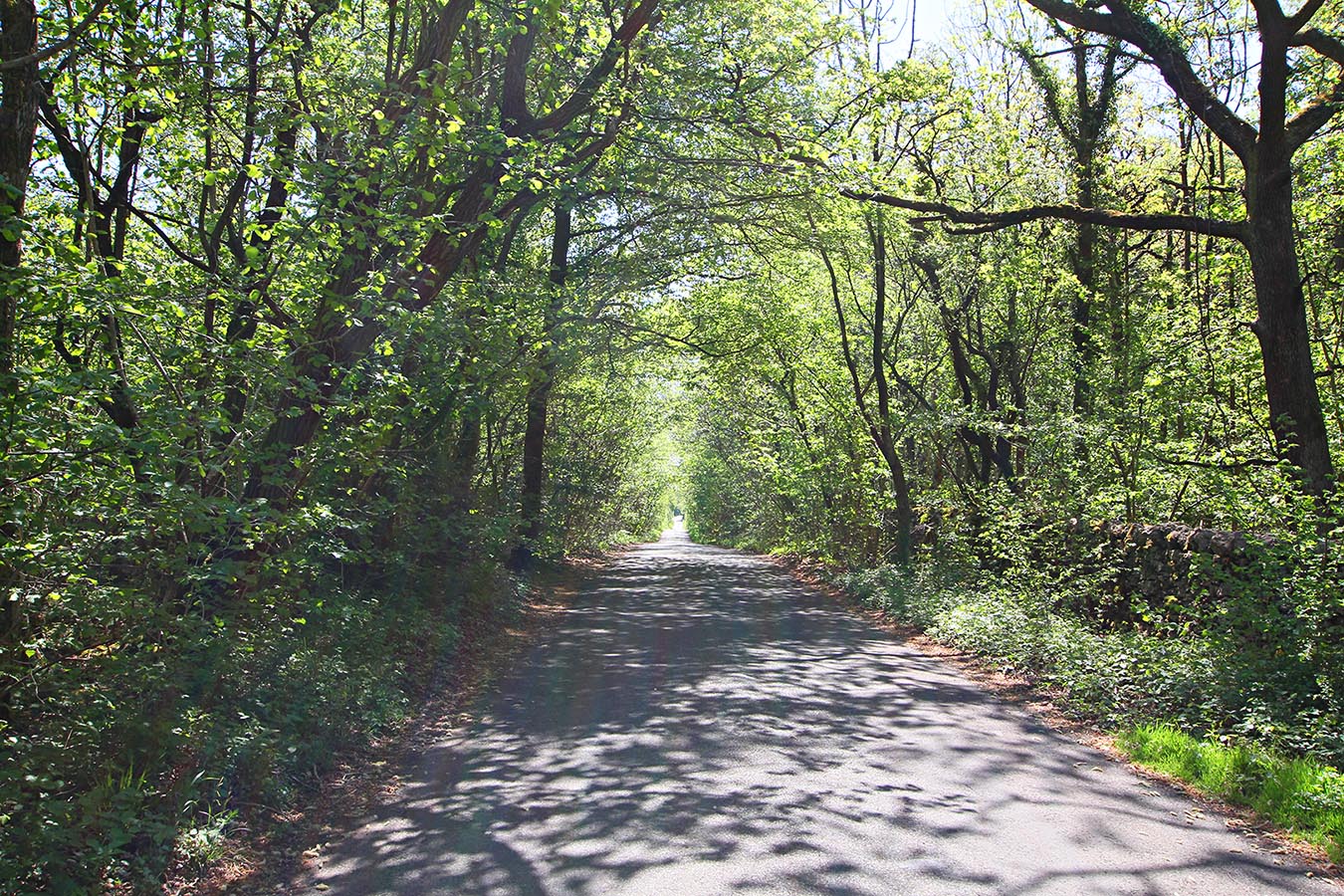 |
Beetham Road looking back towards Leighton Beck Moss We have crossed Thrang End Bridge now and are looking back towards Leighton Beck Moss. It still has marshy areas whereas White Moss/Hale Moss, east (left) of the road, is now drained and reclaimed. The road is now climbing in several straight alignments before it will drop down into Beetham. Image: DR |
Click for larger view |
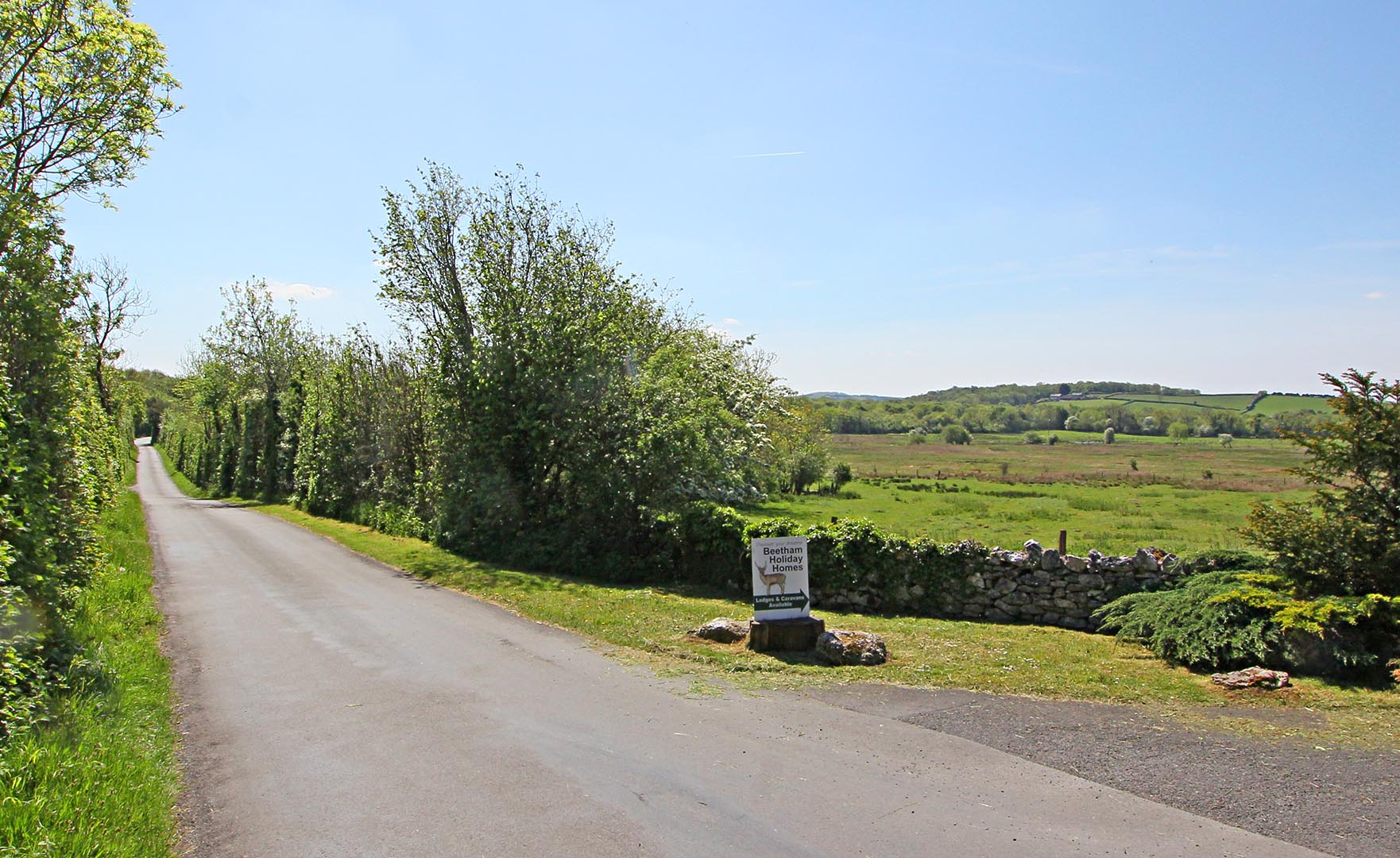 |
Leland's Itinerary - Beetham to Kendal Leland's route now becomes a puzzle! His description of a "preaty river" fits extremely well with Dallam Deer Park. The river around the park is well-known local beauty spot The puzzle is Staunton Beck, presumably Stainton Beck but he doesn't mention Staunton/Stainton itself. He would cross this beck at Rowell Bridge if he turned east at Milnthorpe for Crooklands. At Rowell Bridge the "great beck" description would fit. This is perhaps heading for another Roman road coming in from Yorkshire and approximated by the A65 today. Why he crossed over to that road he does not give us a clue. It would seem highly likely therefore that he left "our" Roman road at Milnthorpe.
|
Click for larger view |
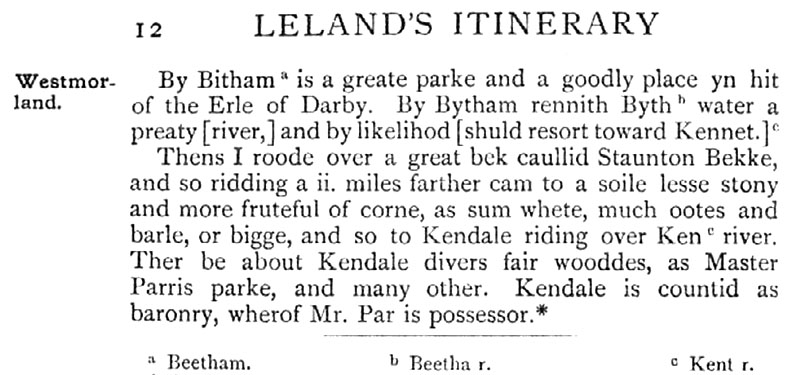 |
Lidar Image and route map - Milnthorpe Thanks to Dr Jean Turnbull we now have a better understanding of the most likely route through Milnthorpe. Jean drew my attention to Curwen’s map of the old roads around Beetham and Dallam Park. The A6 north of Beetham dates from the turnpike era and the earlier line was west of the River Bela through Dallam Deer Park. There is lidar evidence to support this. Leland's description would probably refer to the north end of Dallam Park where the old route crossed the river - see below. |
Click for larger view |
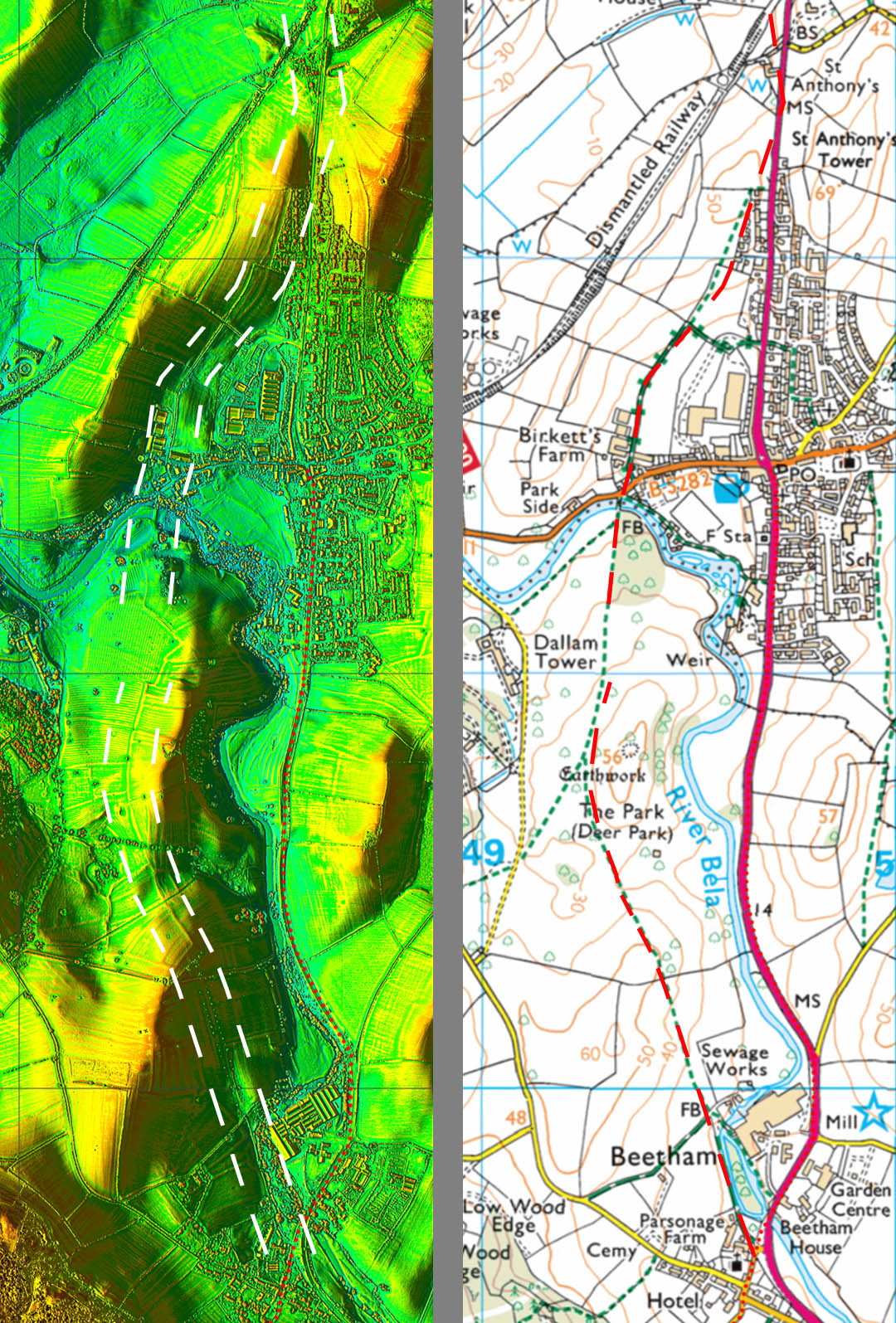 |
River Bela at Milnthorpe Was this spot what Leland had in mind with his "preaty river" description? We are looking south into the park over the old bridge crossing the Bela. Below here the river is tidal so it would be a logical point to bridge the Bela. Image: DR
|
Click for larger view |
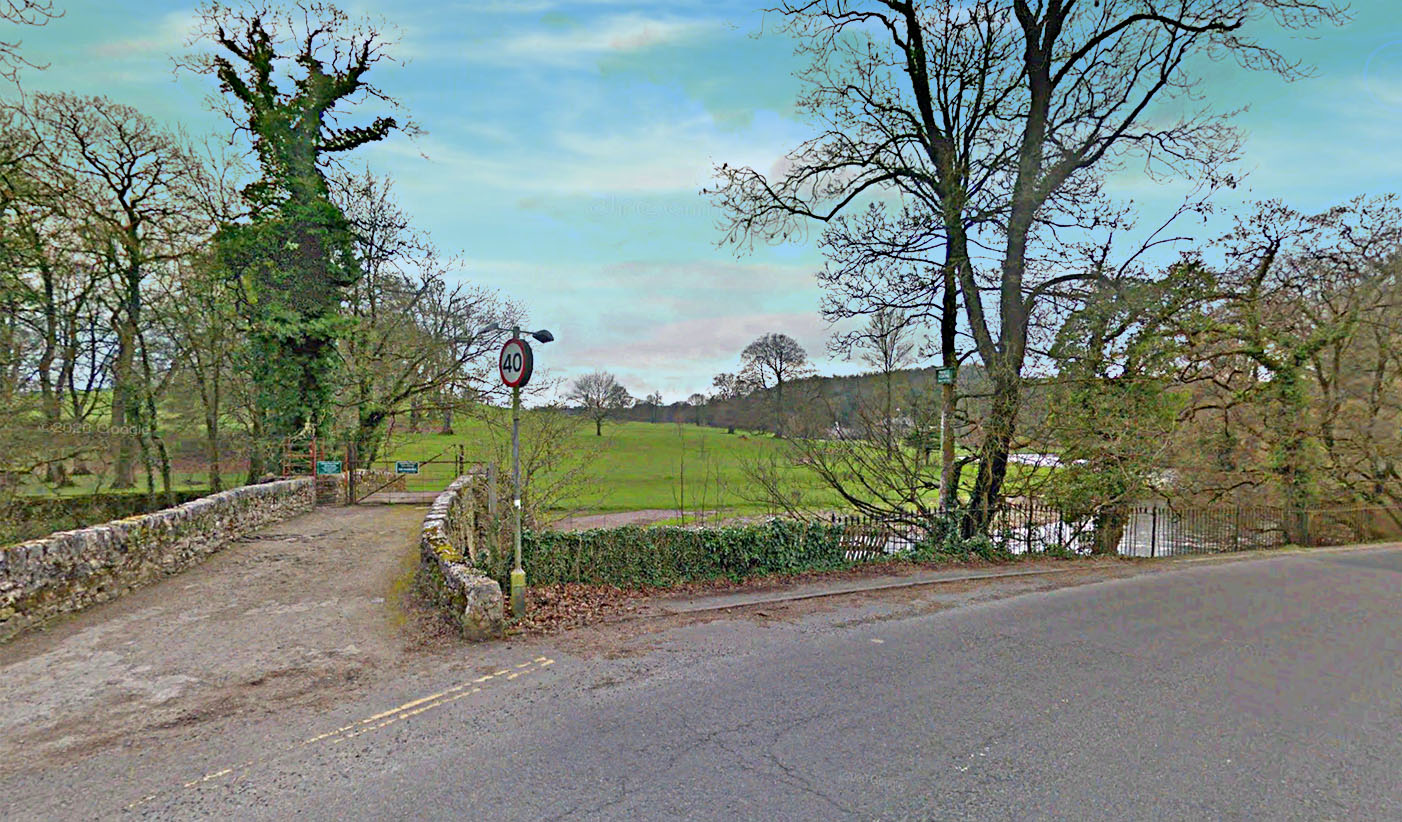 |
NEW VIDEOFor a fly-over along this Roman road from Carnforth to Milnthorpe then click on the video below. For full screen playing then click on the icon bottom right.
|
||
Ordnance Survey First Edition - Beetham to Levens Bridge So if Leland turned right at Milnthorpe what evidence is there for a direct route to Kendal? Lidar has so far revealed no obvious agger north of Beetham. Often, when there is no trace, it can mean that the Roman road is covered by modern roads. Do any modern roads have Roman characteristics? Well certainly the A6 via Beetham-Milnthorpe-Haversham-Leasgill-Levens Bridge does look reasonably convincing with many long straight stretches. It is a logical direct route and does have the benefit of keeping a close coastal connection. The modern A6 now bypasses Heversham and Leasgill. This line would indicate that the road onwards to Watercrook could be on the west bank of the River Kent possibly masked by the old A6 again. The Roman road from Watercrook to Ambleside, the continuation of this road, is also on the west side of Kendal so possibly could align with the road from Lancaster - a common occurrence at Roman forts. Note: near the top of this map, in big letters, is Hincaster - a Roman sounding name if ever there was one. Roman remains were found in the excavated material when the A590 was constructed (Potter CWAAS 1975). These were believed to have come from Tower Hill but the power of modern earth moving machinery has removed any trace. Was this our only Villa?
|
Click for larger view |
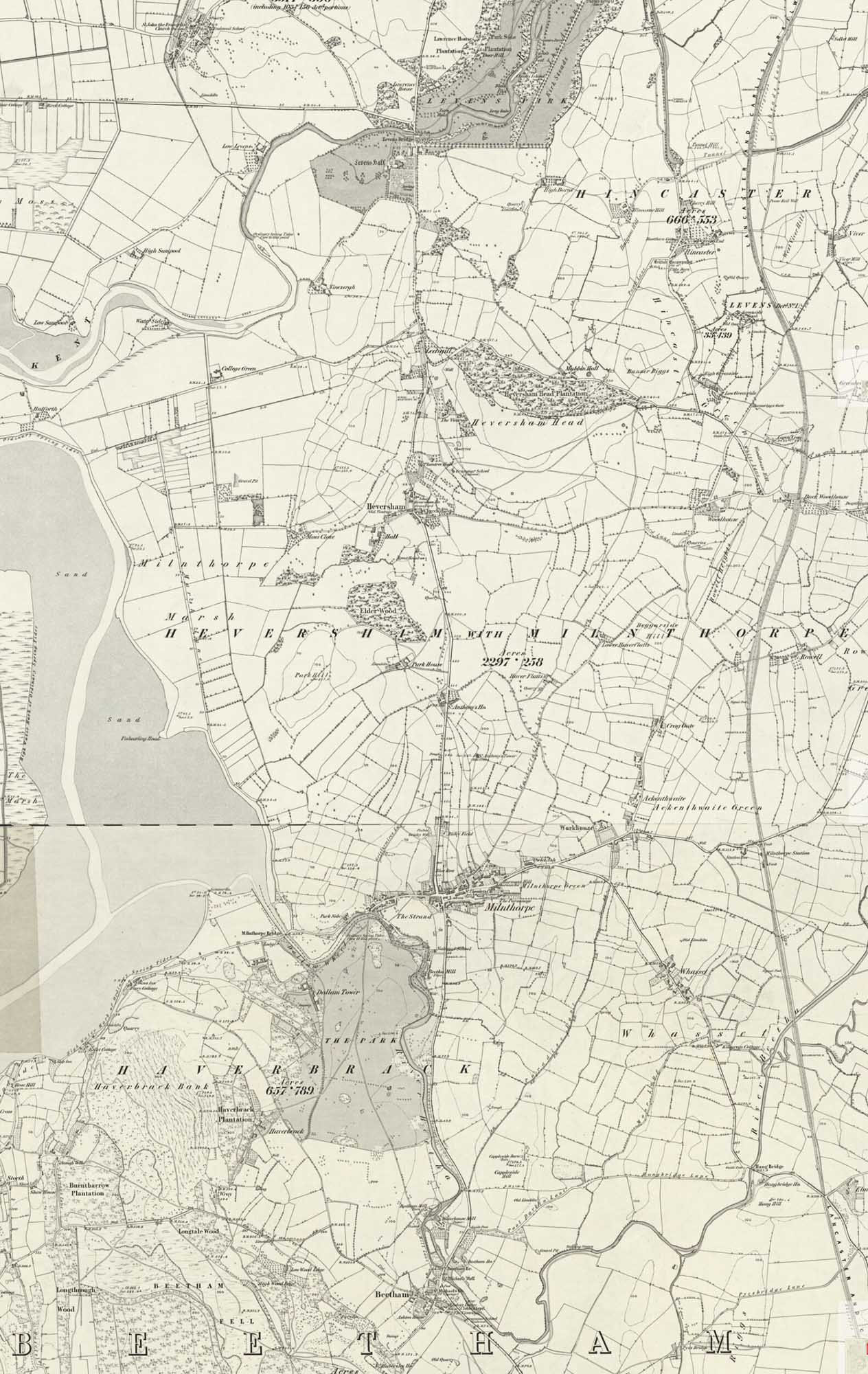 |
Oblique 3D Lidar Image - Milnthorpe to Watercrook It is a reasonably logical route, fairly direct and keeps close to the coast which is a general feature of this road. I have shown it dotted as we really need a bit more proof to be totally certain.
|
Click for larger view |
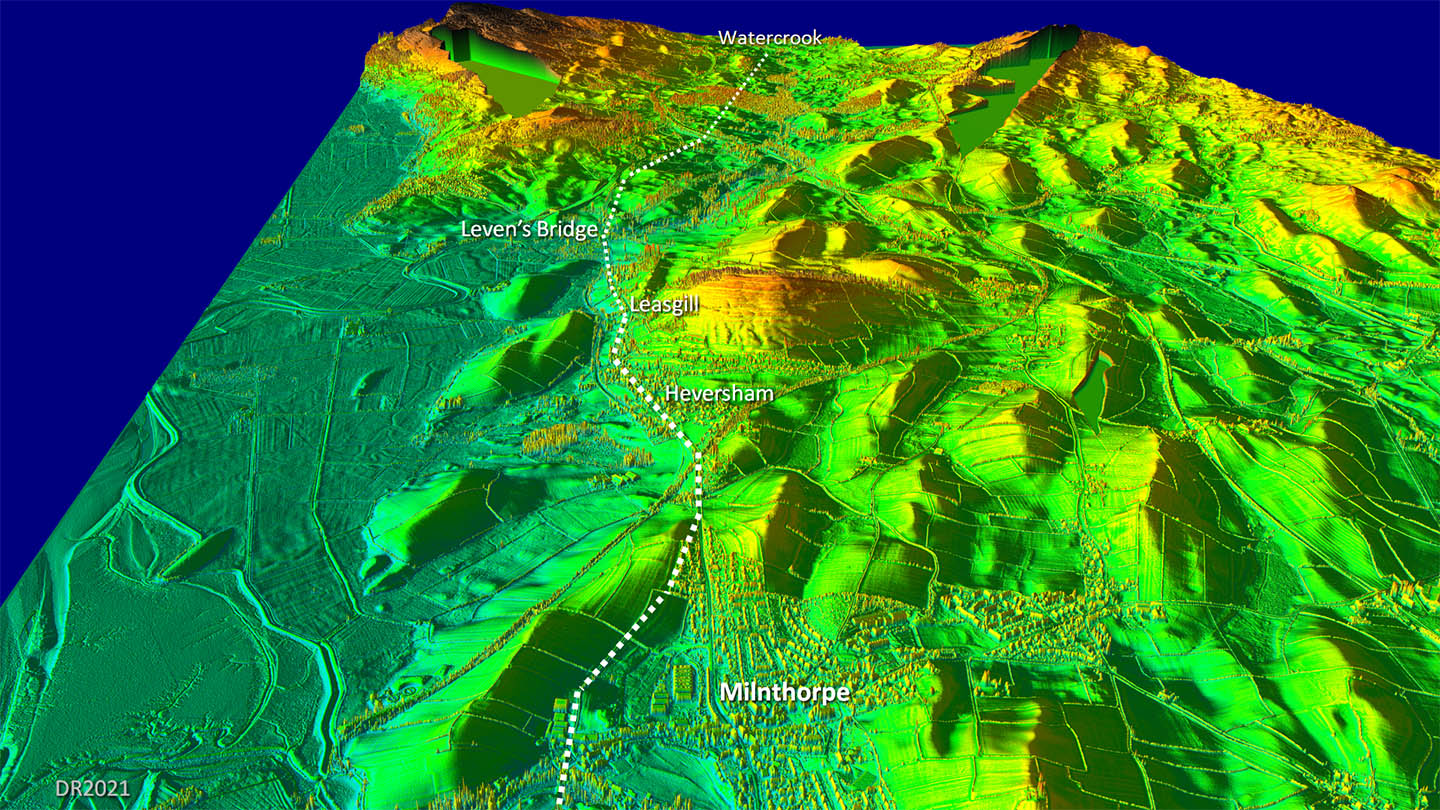 |
Old Road Leasgill - looking South The original A6 and the main road north before Heversham and Leasgill were bypassed. Image: DR |
Click for larger view |
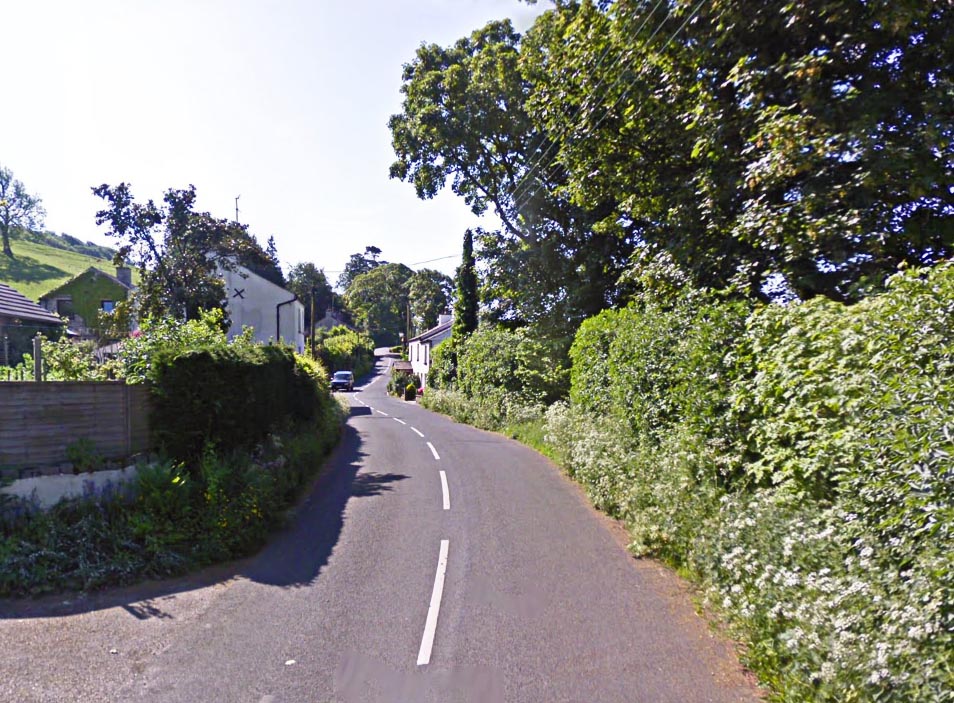 |
Lidar Image, Leven's Bridge - cutting of old road (SD4962 8537) Leven's Bridge is the ancient lowest crossing point of the River Kent. Just north of the river and to the east of the modern A6, there are the clear signs of an old road in a shallow cutting heading north. This would fit well with it being Roman. |
Click for larger view |
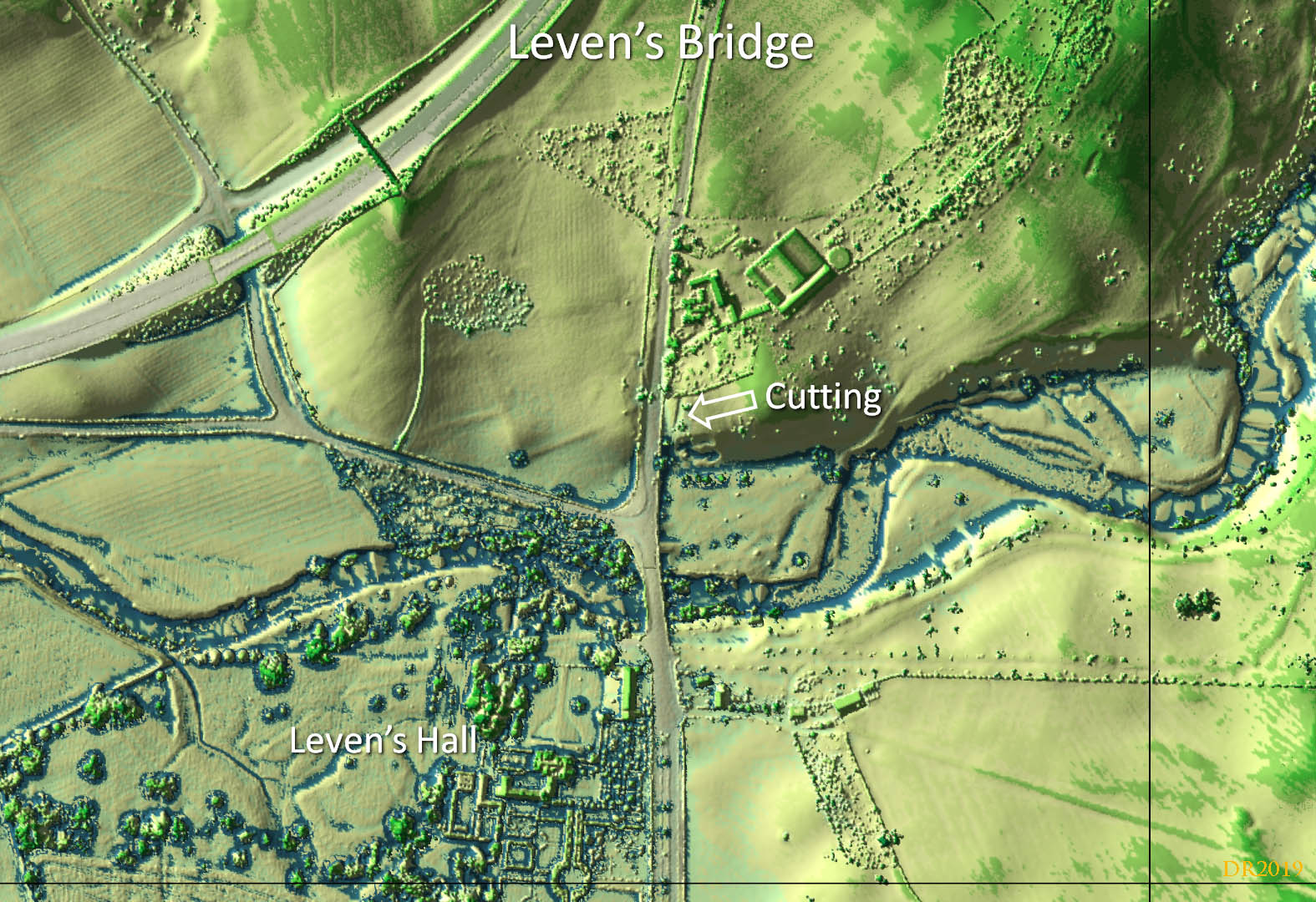 |
Leven's Bridge - cutting of old road (SD4962 8537) This is the on the ground view of the cutting shown above in the lidar image, which I had spotted before I noticed the Lidar evidence. Image: DR |
Click for larger view |
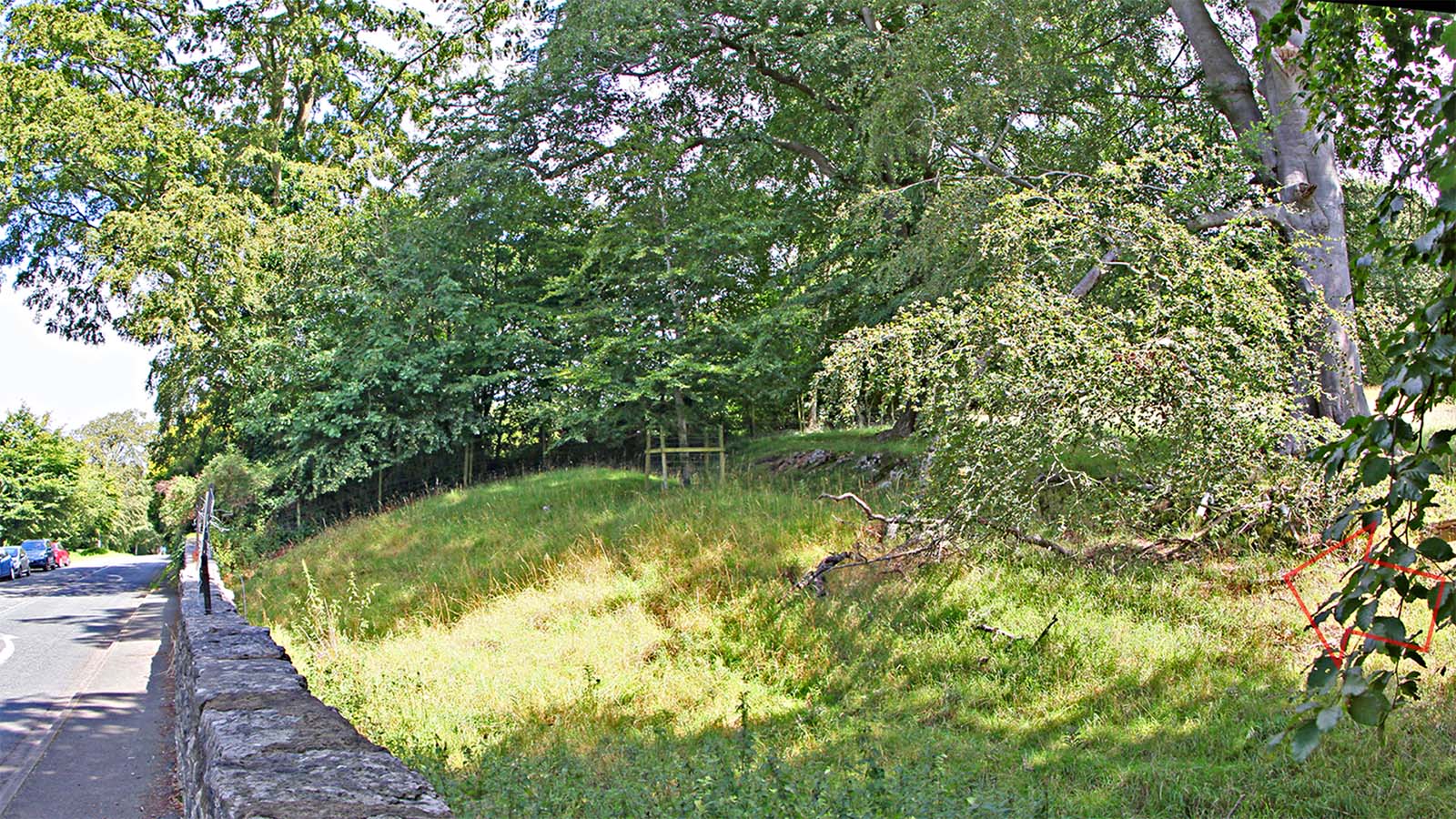 |
Oblique 3D Lidar Image (DTM) - Sizergh Two lengths of possible agger are visible in this Lidar model looking north towards Sizergh Castle. This is a DTM model so vegetation/trees and buildings have been removed. |
Click for larger view |
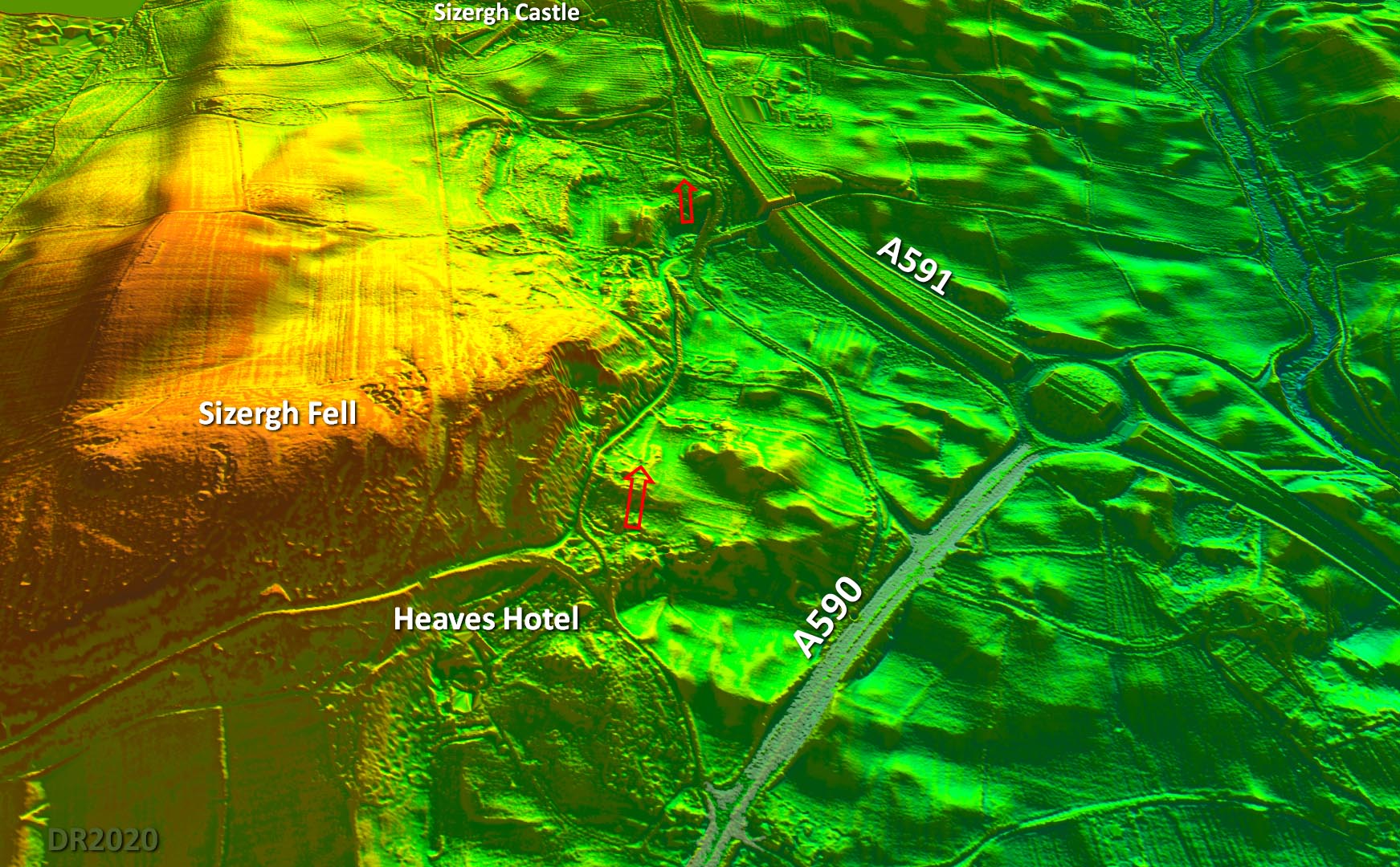 |
Route Map - Leasgill to Watercrook The route follows the Lidar traces above at Leven's Bridge and Sizergh. There is a logic to a route on the west bank of the River Kent and this would fit well with the route to Ambleside which now know comes down from Stainbank Green (see below). What (limited) evidence there is points to a route on the west bank. |
Click for larger view |
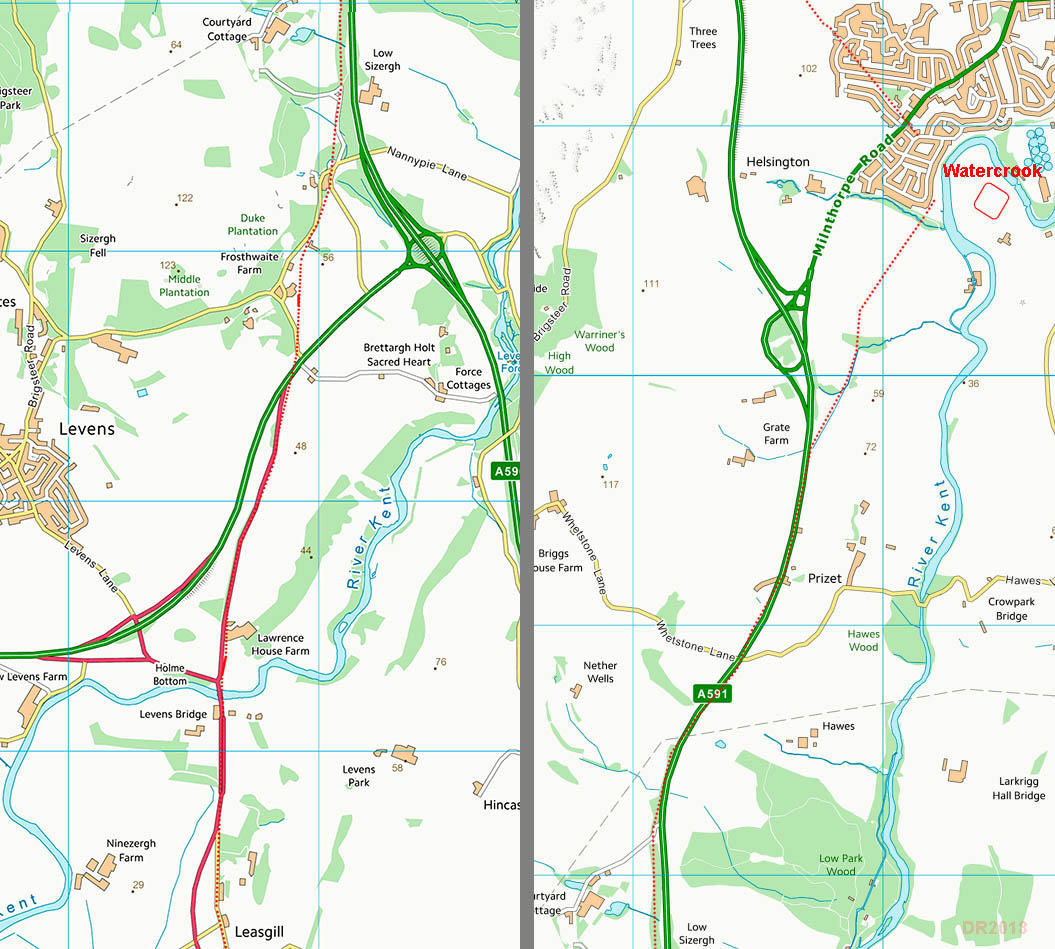 |
Watercrook Roman Fort, Kendal - Lidar & OS First Edition Map Because of upgrades to the A591/A6 I have had to resort to the OS First Edition Map to supplement the Lidar data. A route on the west bank of the River Kent fits well with the route onwards to Ambleside. We now know this comes down from Stainbank Green. They would have shared a common bridge (where the 2 roads would meet) but its position is likely to have been eroded by river movements. There is some Lidar evidence for the old river course but these positions shown should be regarded as best guesses. There is additional support for this alignment in that the route from the south seems to carry on north towards Kendal via a track. The later route via Helsington Laithes was presumably a diversion when the river destroyed the direct route. |
Click for larger view |
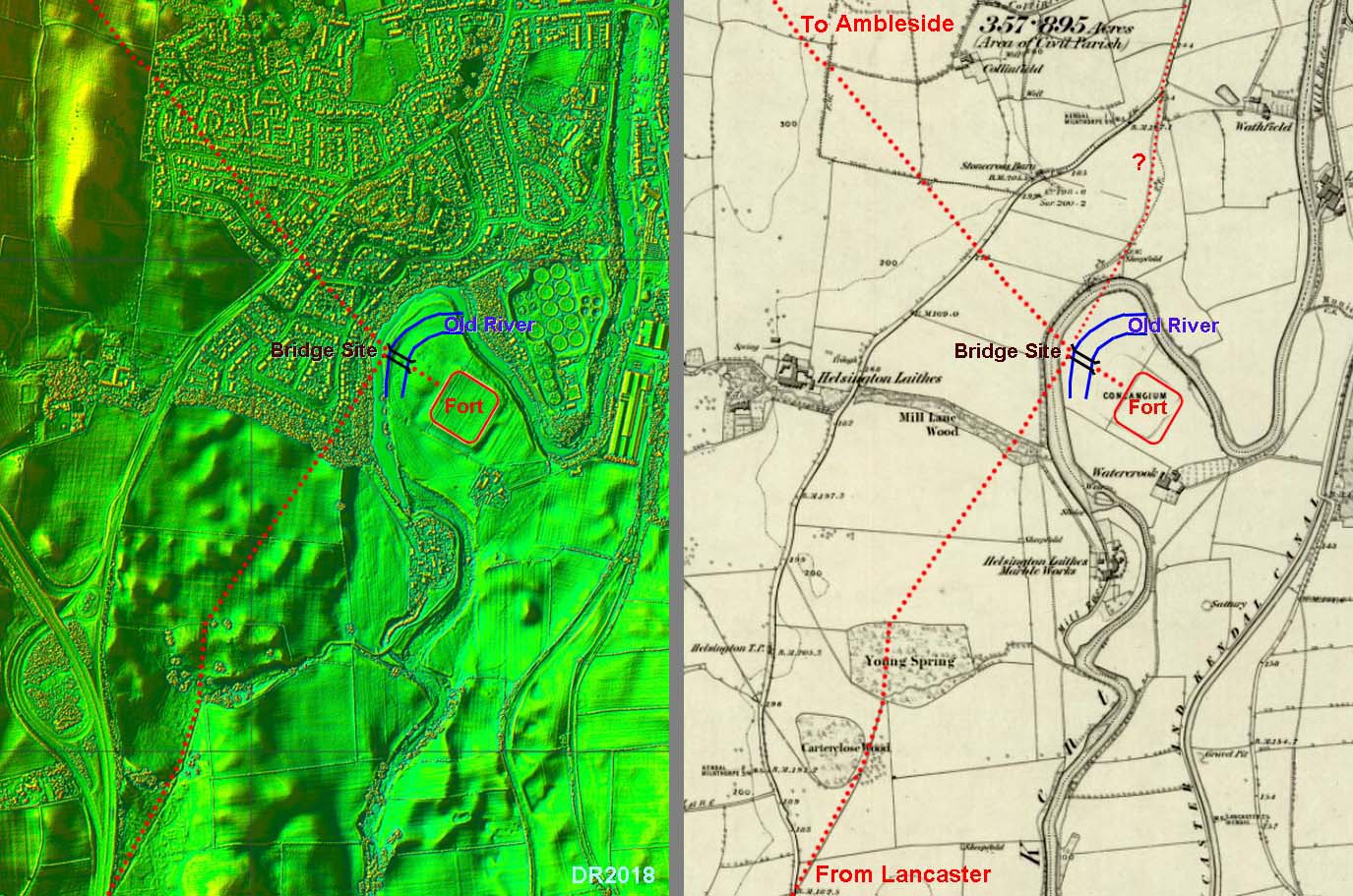 |
3D Lidar Image Watercrook Roman Fort, Kendal - looking south The fort at Watercrook shows up well in the 3D lidar image. Unfortunately any connecting roads do not hence the likelihood the road from Lancaster is on the west side of the river. For David Shotter's article in Contrebis 2000 on Watercrook - see link |
Click for larger view |
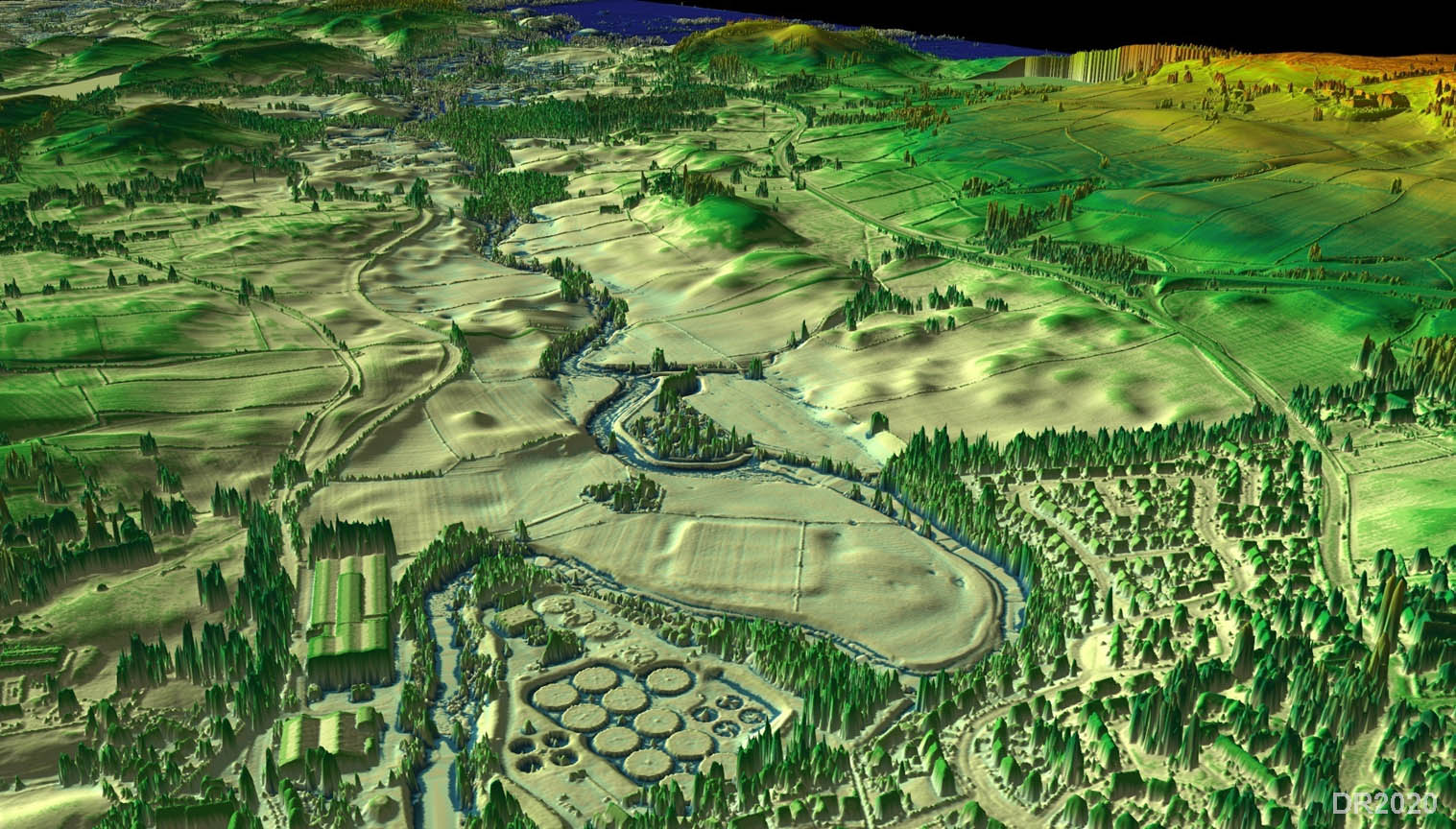 |
|
|
|
Last update: October 2025 |
© David Ratledge |
